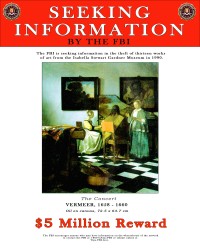 But they aren’t telling. On Monday, March 18th, 23 years to the day after two men disguised as cops “arrested” the security guards at the Isabella Stewart Gardner Museum and helped themselves to three Rembrandts including his own known seascape, a landscape by Rembrandt’s student Govaert Flinck, a Vermeer, a Manet, five Degas drawings, a bronze Napoleonic eagle finial and an ancient Chinese bronze beaker, the FBI announced that they think they know the identity of the culprits.
But they aren’t telling. On Monday, March 18th, 23 years to the day after two men disguised as cops “arrested” the security guards at the Isabella Stewart Gardner Museum and helped themselves to three Rembrandts including his own known seascape, a landscape by Rembrandt’s student Govaert Flinck, a Vermeer, a Manet, five Degas drawings, a bronze Napoleonic eagle finial and an ancient Chinese bronze beaker, the FBI announced that they think they know the identity of the culprits.
“The FBI believes with a high degree of confidence that in the years after the theft, the art was transported to Connecticut and the Philadelphia region, and some of the art was taken to Philadelphia, where it was offered for sale by those responsible for the theft.” [Special agent in charge of the FBI’s Boston office Richard] DesLauriers added, “With that same confidence, we have identified the thieves, who are members of a criminal organization with a base in the Mid-Atlantic states and New England.”
 Given the focus on New England crime families, this may be related to the FBI’s attempt to get senior citizen mobster and alleged prescription pill dealer Robert Gentile to cough up information they believed he had regarding “stolen property out of the District of Massachusetts” last year. After decades of dead ends and little activity, the investigation picked up real steam again in 2010 when new evidence was discovered pointing to the identity of the thieves and the path the art took after the theft.
Given the focus on New England crime families, this may be related to the FBI’s attempt to get senior citizen mobster and alleged prescription pill dealer Robert Gentile to cough up information they believed he had regarding “stolen property out of the District of Massachusetts” last year. After decades of dead ends and little activity, the investigation picked up real steam again in 2010 when new evidence was discovered pointing to the identity of the thieves and the path the art took after the theft.
Knowing whodunit doesn’t tell us where the art works, valued at $500 million but priceless in art historical terms, are today, however. The last known stop was the attempted sale in Philadelphia ten years ago. That’s part of the reason the FBI has chosen not to divulge the name of the thieves. The statute of limitations has long since run out on the original theft and agents believe the paintings have changed hands several times since then. The announcement is meant to engender wider coverage of the story, to remind people there’s a $5 million reward on the line for anyone who can provide information leading to the recovery of the works in good condition, not to initiate a manhunt but rather an arthunt.
 Anthony Amore, the Gardner’s chief of security:
Anthony Amore, the Gardner’s chief of security:
“You don’t have to hand us the paintings to be eligible for the reward. We hope that through this media campaign, people will see how earnest we are in our attempts to pay this reward and make our institution whole. We simply want to recover our paintings and move forward. Today marks 23 years since the robbery. It’s time for these paintings to come home.”
In fact, the FBI, the museum and the U.S. Attorney’s office all emphasized in the announcement that their interest is in getting the paintings back. Not even the law is interested in securing convictions for the greatest art heist of all time. As far as they’re concerned, once the paintings are back home in the Gardner, the case is closed.
Richard DesLauriers:
“The recovery of the paintings will mark the close of a 23-year FBI investigation. The successful return of the paintings to the Gardner Museum would be the final chapter in one of the most significant art theft cases in the FBI’s history. And it is a result we would all welcome — seeing these paintings returned to their rightful home.”
Massachusetts U.S. Attorney Carmen M. Ortiz:
“As we have said in the past, the U.S. Attorney’s Office will consider the possibility of immunity from criminal prosecution for information that leads to the return of the paintings based on the set of facts and circumstances brought to our attention. Our primary goal is, and always has been, to have the paintings returned.”
Special Agent Geoff Kelly, heads of the FBI’s Gardner theft investigation:
“It’s likely over time someone has seen the art hanging on a wall, placed above a mantel, or stored in an attic. We want that person to call the FBI.”
 I suppose there are some grounds for optimism that the paintings are still together and just stashed somewhere. They were kept for 13 years before the attempted Philly sale, so what’s another ten? If you’re in New England and have any kind of connection to current or former mob types, start looking closely at what’s hanging on their walls.
I suppose there are some grounds for optimism that the paintings are still together and just stashed somewhere. They were kept for 13 years before the attempted Philly sale, so what’s another ten? If you’re in New England and have any kind of connection to current or former mob types, start looking closely at what’s hanging on their walls.
The FBI has set up a dedicated website on the Gardner Museum theft. In addition to information about the theft, there are podcasts and videos discussing the investigation and a gallery of high resolution images of all the stolen pieces. The Gardner also has an excellent web page on the theft with detailed information and good pictures of the stolen works (delete the size parameters in the url to see them in high res).
You can submit a tip to the FBI website, call the FBI’s hotline at 1-800-CALL-FBI, or contact museum security director Anthony Amore at (617) 278-5114 or via email at theft@gardnermuseum.org.
you know some rich a-hole is enjoying them,I hope the works are returned some day.
It’s interesting to compare the Rembrandt drawing to the painting recently authenticated as a Rembrandt self portrait:
http://news.sky.com/story/1066160/rembrandt-self-portrait-discovered-in-devon
No prison due to statute of limitations, Just return the art & someone will get $5M. No wonder this org. crime career is so romanticized.
you know some rich a-hole is enjoying them,I hope the works are returned some day.
There’s a school of thought that the thieves stole it much as gnomes steal underpants, without making the connection to profits. So it could just as well be in a mailer tube somewhere in Southie.
I love these posters. It looks like the FBI wants to find Rembrandt and his accomplices Chez Tortoni and the (unidentified) lady and gentleman in black for the crime. They even have a “police sketch” of Rembrandt on there.
Have you seen this man? This crew was last seen in a landscape with and obelisk and may have traveled to the Sea of Galilee by boat. Please notify the FBI if you see these people in a concert bathed in charming, naturalistic light. $5 Million reward leading to the arrest of these people.
Apparently, the Department of Justice stole them:
“With that same confidence, we have identified the thieves, who are members of a criminal organization with a base in the Mid-Atlantic states and New England.”
Must not have been that hard.
I’m wondering about the [sic} after “mantel”. That usage seems perfectly acceptable. And I know that if I owned a Rembrandt, I’d hang it over my mantel!
Right you are. I shall de-sic and then be sure to put that Rembrandt I’ve been keeping in the attic all this time over my mantel. 😉